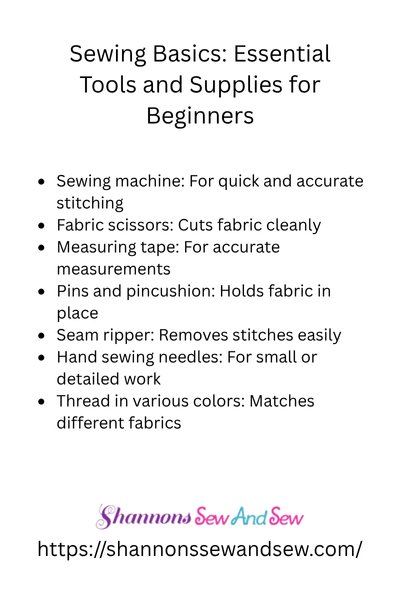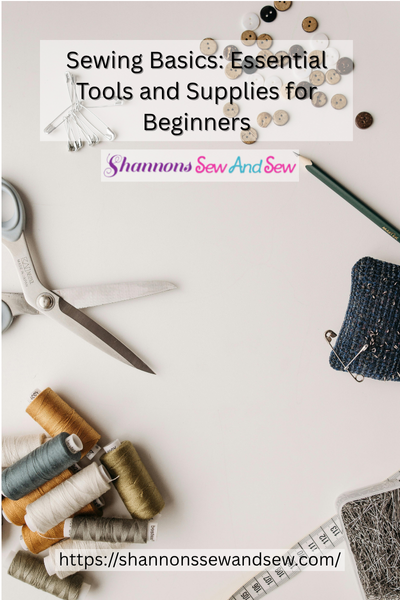Supplies And Equipment
Sewing Basics: Essential Tools and Supplies for Beginners
If you’re just getting started with sewing, you’re probably wondering what you actually need. I get it—walking into a craft store or scrolling online can feel like stepping into a different universe. Good news? You don’t need a truckload of stuff. With just a few essentials, you’ll be stitching up your first project before you can say “bobbin.” Let’s talk sewing basics: essential tools and supplies for beginners, and what you really need to get going.
Read More About Sewing Basics: Essential Tools and Supplies for Beginners

My First Sewing Kit (AKA “The Overkill Bag”)
When I first dove into sewing, I bought everything I saw on a YouTube “must-have” list. Needle threaders, buttonhole cutters, fabric glue I never touched, rulers shaped like triangles—I had no clue what half of it did. Guess how much of that I used? Maybe 20%.
So if you’re just dipping your toes in, don’t overthink it (or overspend). Let’s walk through the real-deal sewing basics: essential tools and supplies for beginners that’ll actually help you, not just clutter your space.
More Things to Know About Sewing Basics: Essential Tools and Supplies for Beginners

First Things First: The Sewing Machine
You don’t need a fancy one with a hundred stitches and a touchscreen. A reliable, user-friendly machine with straight and zigzag stitches is perfect. Trust me, you’ll appreciate simplicity when you’re threading your needle for the 17th time. If you’re going vintage, just make sure it still runs smooth and has available parts. (Been there. Learned the hard way.)
Needles and Thread: Don’t Overlook the Obvious
Sounds basic, right? But it’s surprisingly easy to get the wrong stuff. For beginners, universal sewing machine needles in a couple of sizes (like 80/12 and 90/14) will get you started. And grab good-quality thread—cheap stuff snaps like dry spaghetti. Go for polyester thread; it’s strong, versatile, and plays nicely with most fabrics.
Scissors Matter More Than You Think
If you use your kitchen scissors on fabric, a sewing fairy loses her wings. Okay, not really—but you’ll end up with jagged edges and serious regret. Invest in fabric scissors and keep them far, far away from paper. Also, grab some small snips for trimming threads. They’re like the sidekicks of the sewing world—small, sharp, and totally underrated.
Pins, Clips, and the Battle of Tiny Things
Here’s where it gets personal. I used to hate pins. They poked me more than they held anything in place. Then I discovered sewing clips. Game-changer. Use both and see what you like. Just make sure you’ve got a magnetic pin holder or a tomato cushion (you’ve seen those red puffballs, right?) so you’re not chasing sharp things across the floor. Ask me how I know.
Measuring Tools: Not Sexy, But So Necessary
You’ll need a measuring tape, and probably a seam gauge too. Nothing fancy. But accurate measurements are what separate “cool DIY project” from “what happened here?” Trust me—eyeballing it only gets you so far.
Fabric Choices: Start Simple
Picking fabric is honestly the fun part—and the intimidating one. I recommend starting with cotton. It doesn’t stretch, it holds its shape, and it doesn’t slide around like satin at a dance party. You’ll thank yourself. Plus, cotton comes in about a zillion prints, so you can show off your style right away.
Bobbins, Seam Rippers, and Other Little Lifesavers
Let’s talk bobbins. You’ll need extras. Get a little box to keep them organized, especially if you’re using different colors of thread. And whatever you do—don’t forget a seam ripper. I used to think using one meant I messed up. Nope. It means you’re sewing. Everyone rips stitches. Seam rippers are the unsung heroes of every project.
A Small Iron and an Even Smaller Ironing Board
Here’s a surprise: pressing your fabric and seams can seriously upgrade your results. Even a quick pass with the iron makes your pieces look polished. You don’t need an industrial steamer—just a compact iron and somewhere to press (a towel on a table works in a pinch). I avoided pressing for years. Now I iron more than I sew. No joke.
Organizing Your Supplies (or Trying To)
Let me warn you now—sewing supplies have a sneaky way of multiplying. One minute you have a tidy basket, the next it’s a chaotic drawer of tangled threads and mystery tools. Try to stay on top of it early. Tackle boxes, small containers, or even zip bags help keep your essentials within reach.
Start Strong With the Right Sewing Tools and Supplies
You don’t need a studio full of gadgets to fall in love with sewing. You just need the sewing basics: essential tools and supplies for beginners—a few good tools, a dash of patience, and a willingness to laugh when things go sideways (because they will).
Before long, you’ll have a rhythm. The machine won’t scare you. You’ll instinctively reach for the right tool. You’ll realize that bobbin cases aren’t a mystery after all. And that’s when the real fun begins.
So start simple. Start smart. And most of all—start. I’ll be cheering you on (from a safe distance so I don’t trip over my own fabric pile).




















